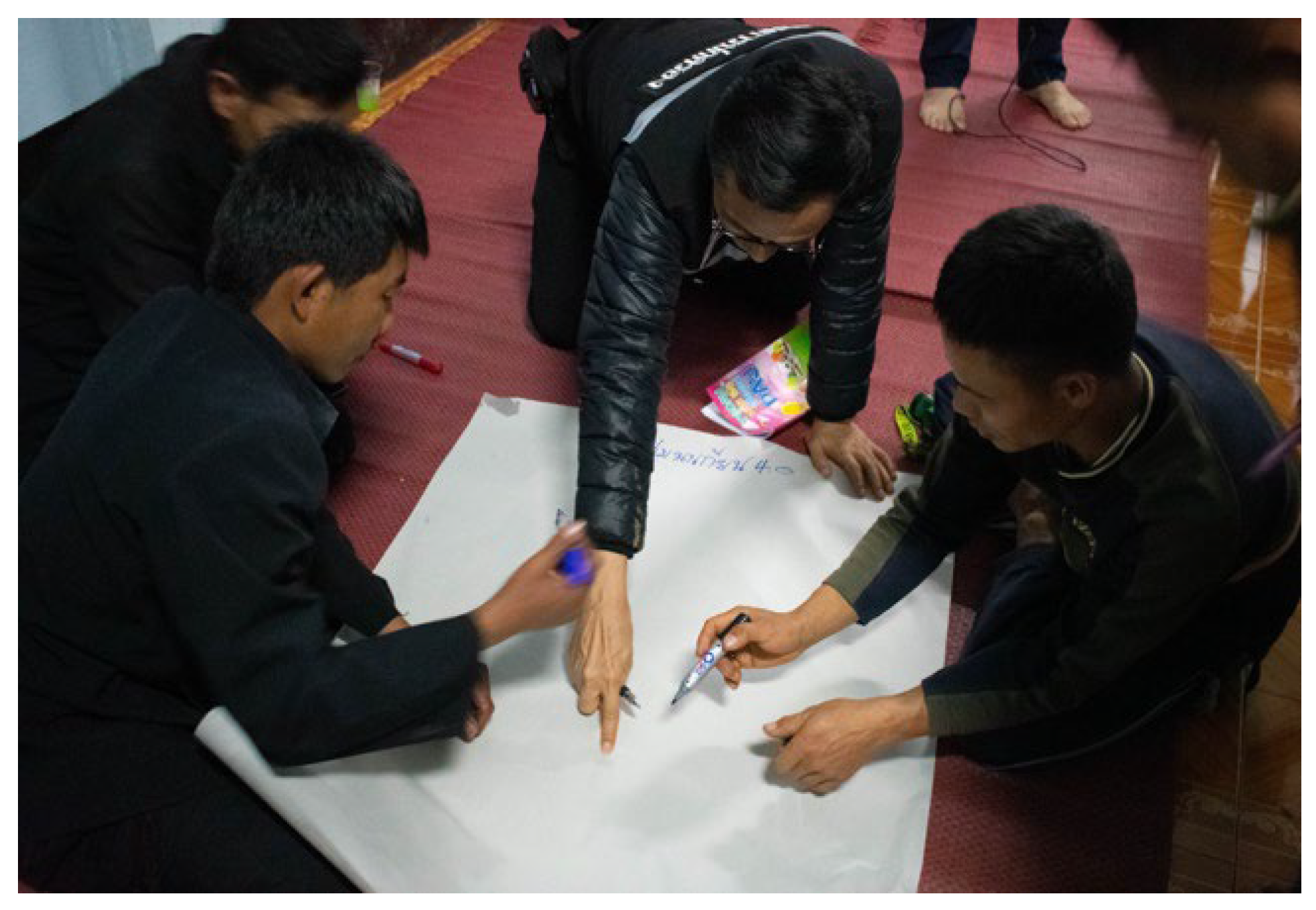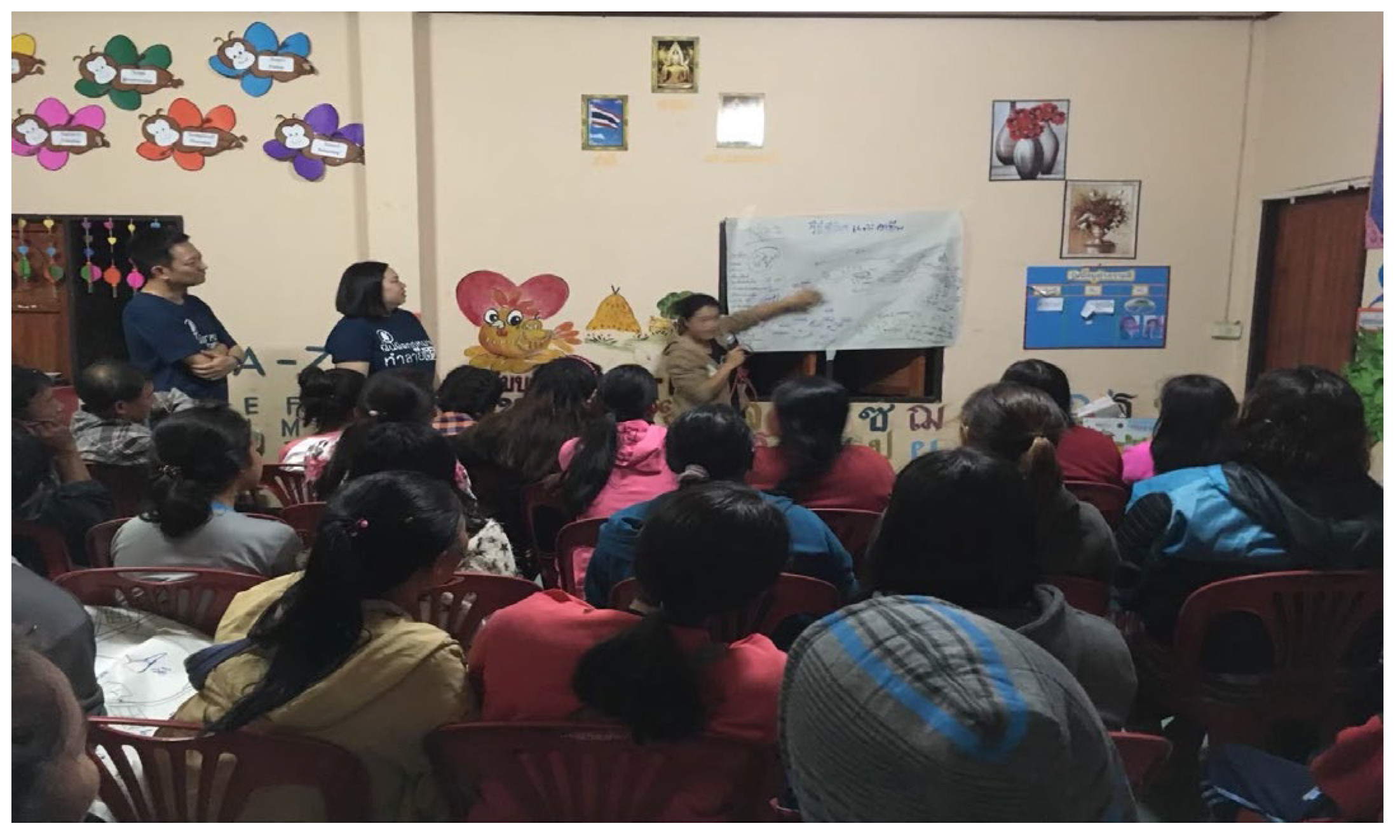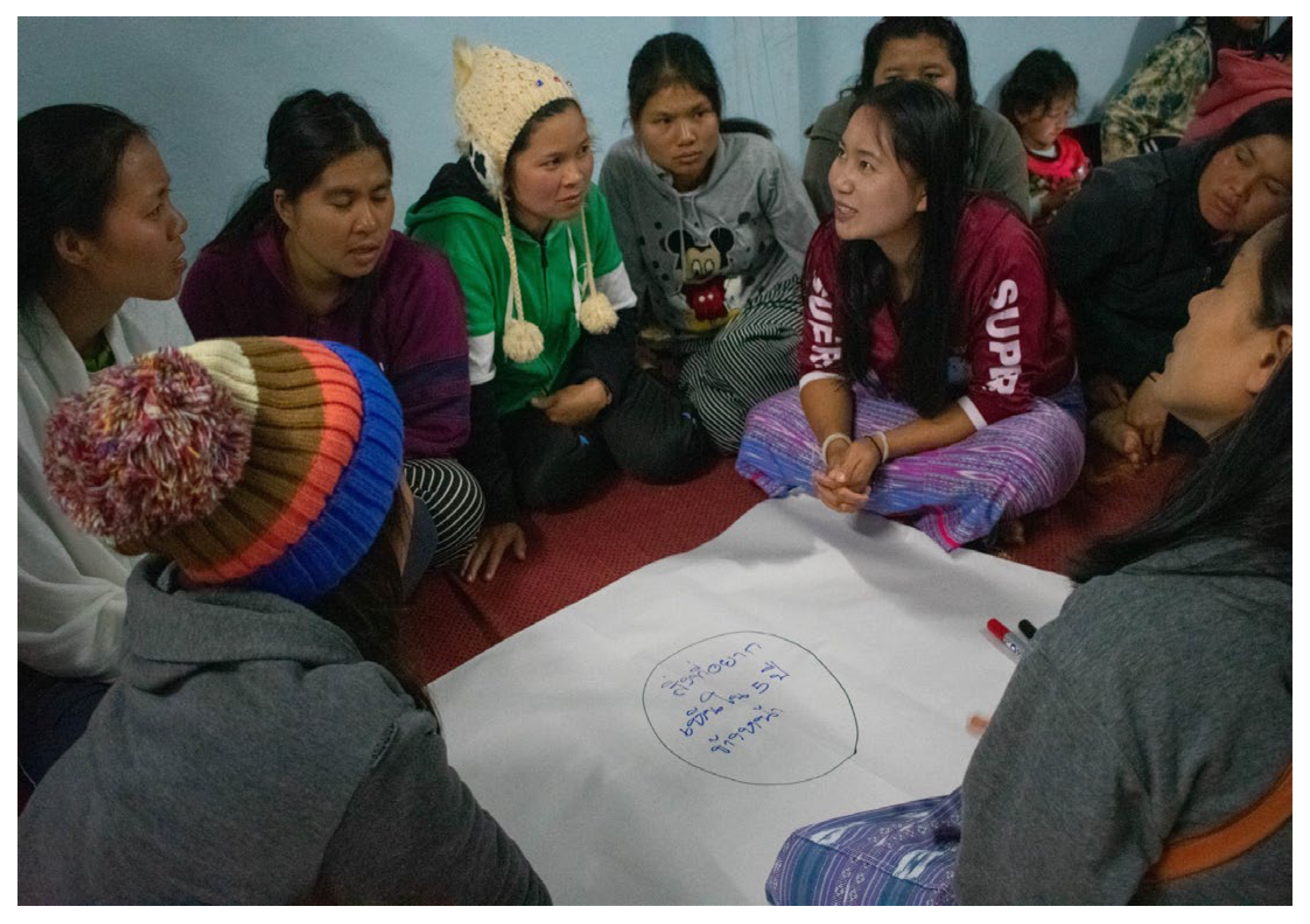Planning Sustainable Community-Based Tourism in the Context of Thailand: Community, Development, and the Foresight Tools
Abstract
:1. Introduction
2. Literature Review
2.1. Tourism Planning and CBT Development
2.2. Foresight Strategies: Empowering Realization
3. Materials and Methods
3.1. The Research Site
3.2. Research Design
3.2.1. Community Arts Methodology: A Drawing Workshop
3.2.2. Community Goal Setting: An In-Depth Discussion Focus Group
3.3. Sampling and Data Collection
3.4. Data Collection and Analysis
3.4.1. Village Sketch Map: Understanding the Current Situation
3.4.2. Future Goals: Anticipation for Tourism Development
4. Results and Analysis
4.1. The Art Workshop
4.2. The Goal Setting
5. Conclusions
Author Contributions
Funding
Institutional Review Board Statement
Informed Consent Statement
Data Availability Statement
Conflicts of Interest
References
- Richards, G.; Hall, D. The community: A sustainable concept in tourism development. In Tourism and Sustainable Community Development; Richards, G., Hall, D., Eds.; Routledge: London, UK, 2000; pp. 1–13. [Google Scholar]
- Whitney-Squire, K.; Wright, P.; Alsop, J.G. Improving Indigenous local language opportunities in community-based tourism initiatives in Haida Gwaii (British Columbia, Canada). J. Sustain. Tour. 2018, 26, 173–191. [Google Scholar] [CrossRef]
- Chatkaewnapanon, Y. A Tourism History of Koh Samui, Thailand: Change and Adaptation in the Tourism Period; LAP Lambert Academic Publishing: Saarbrucken, Germany, 2012. [Google Scholar]
- Wen, T.; Zhang, Q.; Song, L.; Li, Y. Corporate social responsibility, social bonding and place attachment among entrepreneurs of small and medium-sized tourism enterprises. Int. J. Tour. Res. 2021, 24, 189–201. [Google Scholar] [CrossRef]
- World Tourism Organization. Tourism and Community Development—Asian Practices; World Tourism Organization: Madrid, Spain, 2008. [Google Scholar]
- The Thailand Community Base Institute. Community Based Tourism. 2013. Available online: http://cbtnetwork.org/ (accessed on 20 March 2022).
- Dukic, V.; Volic, I. The importance of documenting and including traditional wisdom in community-based ecotourism planning: A case study of the Nature Park Ponjavica in the Village of Omoljica (Serbia). SAGE Open 2017, 7, 1048. [Google Scholar] [CrossRef]
- Moscardo, G. Community capacity building: An emerging challenge for tourism development. In Building Community Capacity for Tourism Development; Moscardo, G., Ed.; Centre for Agriculture and Bioscience International: Oxfordshire, UK, 2008; pp. 1–15. [Google Scholar]
- UNDP. Foresight Manual—Empowered Futures. 2018. Available online: https://www.undp.org/content/undp/en/home/librarypage/capacity-building/global-centre-for-public-service-excellence/ForesightManual2018.html (accessed on 7 December 2021).
- Mbidzo, M.; Newing, H.; Thorn, J.P.R. Can Nationally Prescribed Institutional Arrangements Enable Community-Based Conservation? An Analysis of Conservancies and Community Forests in the Zambezi Region of Namibia. Sustainability 2021, 13, 10663. [Google Scholar] [CrossRef]
- Li, Q.; Dai, M.; Luo, F. Influence of Tourism Disturbance on Soil Microbial Community Structure in Dawei Mountain National Forest Park. Sustainability 2022, 14, 1162. [Google Scholar] [CrossRef]
- World Commission on Environment and Development. Our Common Future; Oxford University Press: Oxford, UK; New York, NY, USA, 1987. [Google Scholar]
- Lee, T.H.; Jan, F.-H. Market segmentation based on the environmentally responsible behaviors of community-based tourists: Evidence from Taiwan’s community-based destinations. Int. J. Tour. Res. 2019, 21, 400–411. [Google Scholar] [CrossRef]
- Zhang, Y.; Xiong, Y.; Lee, T.J.; Ye, M.; Nunkoo, R. Socio-cultural sustainability and the formation of social capital from community-based tourism. J. Travel Res. 2021, 60, 656–669. [Google Scholar] [CrossRef]
- Hua, Y.; Jittithavorn, C.; Lee, T.J.; Chen, X. Contribution of TV Dramas and Movies in Strengthening Sustainable Tourism. Sustainability 2021, 13, 12804. [Google Scholar] [CrossRef]
- Butcher, K.; Chomvilailuk, R. Guest benefits of hedonic value and perceived community value drive hotel CSR participation. J. Sustain. Tour. 2021, 30, 1262–1279. [Google Scholar] [CrossRef]
- Dolezal, C.; Novelli, M. Power in community-based tourism: Empowerment and partnership in Bali. J. Sustain. Tour. 2020, 1–19. [Google Scholar] [CrossRef]
- Park, K.; Lee, J.; Lee, T. Residents’ attitudes toward future tourism development in terms of community well-being and attachment. Asia Pac. J. Tour. Res. 2016, 22, 160–172. [Google Scholar] [CrossRef]
- Salazar, N.B. Community-based cultural tourism: Issues, threats and opportunities. J. Sustain. Tour. 2012, 20, 9–22. [Google Scholar] [CrossRef]
- García-Rosell, J.-C.; Mäkinen, J. An integrative framework for sustainability evaluation in tourism: Applying the framework to tourism product development in Finnish Lapland. J. Sustain. Tour. 2013, 21, 396–416. [Google Scholar] [CrossRef]
- Mayaka, M.; Croy, W.G.; Cox, J.W. Participation as motif in community-based tourism: A practice perspective. J. Sustain. Tour. 2017, 26, 416–432. [Google Scholar] [CrossRef]
- Page, S.; Connell, J. Tourism: A Modern Synthesis, 3rd ed.; Cengage Learning EMEA: Andover, MA, USA, 2009. [Google Scholar]
- Mtapuri, O.; Thanh, T.D.; Giampiccoli, A.; Dłużewska, A. Expansion and Specification of Knowledge, Skills, Attitudes and Practices Survey Model for Community-Based Tourism Development. Sustainability 2021, 13, 10525. [Google Scholar] [CrossRef]
- Nugroho, P.; Numata, S. Resident support of community-based tourism development: Evidence from Gunung Ciremai National Park, Indonesia. J. Sustain. Tour. 2020, 1–16. [Google Scholar] [CrossRef]
- Sarr, B.; Sène-Harper, A.; Gonzalez-Hernandez, M.M. Tourism, social representations and empowerment of rural communities at Langue de Barbarie National Park, Senegal. J. Sustain. Tour. 2021, 29, 1383–1402. [Google Scholar] [CrossRef]
- Lee, T.J.; Riley, M.; Hampton, M.P. Conflict and progress: Tourism development in Korea. Ann. Tour. Res. 2010, 37, 355–376. [Google Scholar] [CrossRef]
- Li, X.; Kim, J.; Lee, T. Collaboration for Community-Based Cultural Sustainability in Island Tourism Development: A Case in Korea. Sustainability 2021, 13, 7306. [Google Scholar] [CrossRef]
- Abdullah, T.; Carr, N.; Lee, C. Re-conceptualising the empowerment of local people in tourism. Int. J. Tour. Res. 2022. [Google Scholar] [CrossRef]
- Xu, S.; Hu, Y. How do residents respond to negative environmental impacts from tourism? The role of community participation in empowering residents’ environmentally responsible behavior. Int. J. Tour. Res. 2021, 23, 1099–1111. [Google Scholar] [CrossRef]
- Mwantimwa, K. Livelihood information and knowledge needs, access, and exchange in rural communities in the Bunda District, Tanzania. Rural Soc. 2020, 29, 30–43. [Google Scholar] [CrossRef]
- Li, X.; Kim, J.; Lee, T. Contribution of Supportive Local Communities to Sustainable Event Tourism. Sustainability 2021, 13, 7853. [Google Scholar] [CrossRef]
- Georghiou, L.; Keenan, M. Evaluation of national foresight activities: Assessing rationale, process and impact. Technol. Forecast. Soc. Chang. 2006, 73, 761–777. [Google Scholar] [CrossRef]
- Karst, H.E.; Nepal, S.K. Social-ecological wellbeing of communities engaged in ecotourism: Perspectives from Sakteng Wildlife Sanctuary, Bhutan. J. Sustain. Tour. 2021, 30, 1177–1199. [Google Scholar] [CrossRef]
- Slaughter, R.A. Futures Beyond Dystopia: Creating Social Foresight; Routledge/Falmer: London, UK, 2004. [Google Scholar]
- Daheim, C.; Uerz, G. Corporate foresight in Europe: From trend based logics to open foresight. Technol. Anal. Strat. Manag. 2008, 20, 321–336. [Google Scholar] [CrossRef]
- Voros, J. A generic foresight process framework. Foresight 2003, 5, 10–21. [Google Scholar] [CrossRef]
- Bishop, C. Artificial Hells Participatory Art and the Politics of Spectatorship; Verso: New York, NY, USA, 2012. [Google Scholar]
- Chatkaewnapanon, Y.; Kelly, J.M. Community arts as an inclusive methodology for sustainable tourism development. J. Place Manag. Dev. 2019, 12, 365–390. [Google Scholar] [CrossRef]
- Anholt, S. Place: Identity, Image and Reputation; Palgrave Macmillan: New York, NY, USA, 2010. [Google Scholar]
- Rawson, P. Title Drawing, 2nd ed.; University of Pennsylvania Press: Philadelphia, PA, USA, 1987. [Google Scholar]
- George, E.W.; Mair, H.; Reid, D.G. Rural Tourism Development: Localism and Cultural Change; Channel View: Bristol, UK, 2009. [Google Scholar]
- Jana, R.K.; Mitra, S.K. Maximizing pleasure in day tours: Utility theory approach. Int. J. Tour. Res. 2020, 23, 532–541. [Google Scholar] [CrossRef]
- Kasper, L.F.; Petrello, B.A. Responding to ESL Student Writing: The Value of a Nonjudgmental Approach. Community Rev. 1998, 6, 181. [Google Scholar]
- Beaven, M.H. Individualized goal setting, self-evaluation, and peer evaluation. In Evaluating Writing: Describing, Measuring, Judging; Cooper, C.R., Odell, L., Eds.; National Council of Teachers of English: Urbana, IL, USA, 1977; pp. 135–156. [Google Scholar]
- Irshad, H. Rural Tourism: An overview. Agriculture and Rural Development, Government of Alberta. 2010. Available online: http://www1.agric.gov.ab.ca/$Department/deptdocs.nsf/all/csi13476/$FILE/Rural-Tourism.pdf (accessed on 19 November 2016).
- Zhang, Y.; Lee, T.J. Alienation and authenticity in intangible cultural heritage tourism production. Int. J. Tour. Res. 2021, 24, 18–32. [Google Scholar] [CrossRef]
- Ochieng, N.T.; Wilson, K.; Derrick, C.J.; Mukherjee, N. The use of focus group discussion methodology: Insights from two decades of application in conservation. Methods Ecol. Evol. 2018, 9, 20–32. [Google Scholar] [CrossRef] [Green Version]
- Chatkaewnapanon, Y.; Leelapattana, W.; Trakansiriwanich, K.; Ek-Iem, B. The Place Identity and the Attractiveness of Rural Thailand: An Approach for Sustainable Tourism Development of Mae Klang Luang in Northern Thailand. Int. J. Asian Soc. Sci. 2017, 7, 708–717. [Google Scholar] [CrossRef] [Green Version]
- Krueger, R.A.; Casey, M.A. Focus Groups: A Practical Guide for Applied Research; Sage: Thousand Oaks, CA, USA, 2000. [Google Scholar]
- Shahzalal, M.; Font, X. Influencing altruistic tourist behaviour: Persuasive communication to affect attitudes and self-efficacy beliefs. Int. J. Tour. Res. 2018, 20, 326–334. [Google Scholar] [CrossRef]



Publisher’s Note: MDPI stays neutral with regard to jurisdictional claims in published maps and institutional affiliations. |
© 2022 by the authors. Licensee MDPI, Basel, Switzerland. This article is an open access article distributed under the terms and conditions of the Creative Commons Attribution (CC BY) license (https://creativecommons.org/licenses/by/4.0/).
Share and Cite
Chatkaewnapanon, Y.; Lee, T.J. Planning Sustainable Community-Based Tourism in the Context of Thailand: Community, Development, and the Foresight Tools. Sustainability 2022, 14, 7413. https://doi.org/10.3390/su14127413
Chatkaewnapanon Y, Lee TJ. Planning Sustainable Community-Based Tourism in the Context of Thailand: Community, Development, and the Foresight Tools. Sustainability. 2022; 14(12):7413. https://doi.org/10.3390/su14127413
Chicago/Turabian StyleChatkaewnapanon, Yuthasak, and Timothy J. Lee. 2022. "Planning Sustainable Community-Based Tourism in the Context of Thailand: Community, Development, and the Foresight Tools" Sustainability 14, no. 12: 7413. https://doi.org/10.3390/su14127413
APA StyleChatkaewnapanon, Y., & Lee, T. J. (2022). Planning Sustainable Community-Based Tourism in the Context of Thailand: Community, Development, and the Foresight Tools. Sustainability, 14(12), 7413. https://doi.org/10.3390/su14127413




